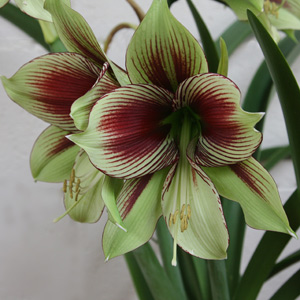
Perhaps the most cold tolerant of all of the Hippeastrums, H.papilio with its fascinating striped flowers is one of the most sought after species.
Hippeastrum papilio is commonly called the ‘Butterfly Hippeastrum’ or Butterfly Amaryllis and it is one of the most sought after species.
The flowers are either a lime green, or creamy lime green with deep Burgundy markings and veins running through the petals.
Sometimes sold as evergreen, and this is true in warmer zones, however in cooler zones it can die back in winter. Generally early flowering the blooms resemble a colorful Butterfly, hence its common name.
This is another Amaryllis that we like to flower ‘out of season. So although it would naturally be spring flowering, we see it in the stores in winter, to brighten or days I guess.
Care
Outdoors Hippeastrum papilio requires some protection from the hot afternoon sun. You can plant them in the ground in an open position. Look for good drainage and light afternoon shade. Try not to worry to much about the soil, they seem to thrive in poor soil.
Indoors it is widely grown in containers. Good drainage is essential, a fine orchid potting mix is one way to ensure it gets the drainage it needs.
It is a species that can be a little temperamental when it comes to flowering, some years it decides to sulk. Usually due to a wet winter, or to much sun the summer before
Buying Hippeastrum papilio
When buying these bulbs look for larger ones, they are more likely to flower the first year and may put up multiple flower stalks.
Also look for bulbs with good fleshy root systems attached, again you will get better results than from those with no roots or dried out root systems.
Avoid bulbs that are soft or show signs of disease.
Propagation
As this is a species, Hippeastrum papilio can be propagated from seed or by division of offsets. The easiest method is by division.
From division of smaller offsets, Hippeastrum papilio will take about 3 – 4 years to flower.
As the bulb forms a larger clump you can divide them if you wish. Best divided late winter. Try to divide so that as much as the root system is attached to the offset as possible.
Seed can be collected and planted immediately,
Problems
Snails and slugs can attach the foliage
Over watering can cause bulb rot.
Other Hippeastrums
Remember that we have been calling these plant Amaryllis for a number of years.
A few species such as Hippeastrum papilio, with wonderful green and deep red flowers are well worth seeking. If you could grow it, H. blossfeldiae is attractive, orange to red flowers with a green center. H. cybister with its spidery flowers is rare but fascinating.
The recently discovered, H. mandonii, lime green flowers with scarlet red tips is rarely offered.
Care
In brief, Hippeastrum like
- Humus rich well drained soil
- Dry winters
- To be planted with the neck of the bulb above soil level.

